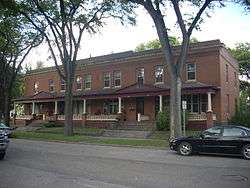Dinnie Apartments
Dinnie Apartments is a building in Grand Forks, North Dakota that was listed on the National Register of Historic Places (NRHP) in 1994. Dinnie Apartments is included in the Grand Forks Near Southside Historic District, which was listed on the NRHP in 2004.[1][2]
Dinnie Apartments | |
 | |
  | |
| Location | 102-108 Fourth Ave. S, Grand Forks, North Dakota |
|---|---|
| Coordinates | 47°55′7″N 97°1′31″W |
| Area | less than 1 acre (0.40 ha) |
| Built | 1903 |
| Architect | Dinnie Brothers |
| Architectural style | Classical Revival |
| NRHP reference No. | 94000555[1] |
| Added to NRHP | June 3, 1994 |
History
It was the first block of "spacious and elegant" townhouses built in Grand Forks at the turn-of-the-century. It was built in 1903 as four townhouses, in Classical Revival style. The south side of the city at that time was being populated by "wealthy merchants" during the Second Dakota Boom.[3]:7 [3] [4]
It was built by the firm of Dinnie Brothers. John Dinnie (1853–1910) and James Dinnie (1863–1938) founded the contracting firm of Dinnie Brothers in the middle eighteen eighties. The firm was were especially active in the rebuilding of Fargo after the destruction of much of the city by fire in 1894. They also both served as mayors of Grand Forks. [5][6] [7]
See also
References
- "National Register Information System". National Register of Historic Places. National Park Service. March 13, 2009.
- Ann Emmons; Connie Walker-Gray; Mike Warren (October 2003). "NRHP Registration: Grand Forks Near Southside Historic District". National Park Service. and Accompanying 20 photos from 2003
- Norene Roberts (June 21, 1992). "NRHP Inventory-Nomination: Dinnie Apartments / 32GF634". National Park Service. and Accompanying three photos, exterior, from 1992
- "The Great Dakota Boom". State Historical Society of North Dakota. Retrieved February 1, 2020.
- "John Dinnie". Grand Forks Daily Herald, December 9, 1910. Retrieved February 1, 2020.
- "James A. Dinnie". Grand Forks Herald, February 9, 1938. Retrieved February 1, 2020.
- "The Fargo Fire of 1893". Fargo History Project. Retrieved February 1, 2020.